
Megalosaurus is an extinct genus of large carnivorous theropod dinosaurs of the Middle Jurassic Epoch of southern England. Although fossils from other areas have been assigned to the genus, the only certain remains of Megalosaurus come from Oxfordshire and date to the late Middle Jurassic.

Carnosauria is an extinct group of carnivorous theropod dinosaurs that lived during the Jurassic and Cretaceous periods.

Afrovenator is a genus of megalosaurid theropod dinosaur from the Middle or Late Jurassic Period on the Tiourarén Formation and maybe the Irhazer II Formation of the Niger Sahara region in northern Africa. Afrovenator represents the only properly identified Gondwanan megalosaur, with proposed material of the group present in the Late Jurassic on Tacuarembó Formation of Uruguay and the Tendaguru Formation of Tanzania.
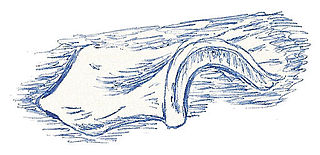
Iliosuchus is a genus of theropod dinosaur known from Bathonian–age rocks of England. It was perhaps 2 metres (6.6 ft) long.
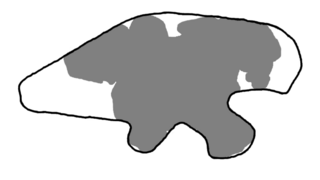
Metriacanthosaurus is a genus of metriacanthosaurid dinosaur from the upper Oxford Clay of England, dating to the Late Jurassic period, about 160 million years ago.

Altispinax is a genus of large predatory theropod dinosaur from the Early Cretaceous period of what is now the Wadhurst Clay Formation of East Sussex, England.
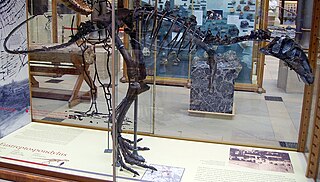
Eustreptospondylus is a genus of megalosaurid theropod dinosaur, from the Oxfordian stage of the Late Jurassic period in southern England, at a time when Europe was a series of scattered islands.

Megalosauridae is a monophyletic family of carnivorous theropod dinosaurs within the group Megalosauroidea. Appearing in the Middle Jurassic, megalosaurids were among the first major radiation of large theropod dinosaurs. They were a relatively primitive group of basal tetanurans containing two main subfamilies, Megalosaurinae and Afrovenatorinae, along with the basal genus Eustreptospondylus, an unresolved taxon which differs from both subfamilies.

Piatnitzkysaurus is a genus of megalosauroid theropod dinosaur that lived approximately 179 to 177 million years ago during the lower part of the Jurassic Period in what is now Argentina. Piatnitzkysaurus was a moderately large, lightly built, bipedal, ground-dwelling carnivore that could grow up to 6.6 m (21.7 ft) long.

Megalosauroidea is a superfamily of tetanuran theropod dinosaurs that lived from the Middle Jurassic to the Late Cretaceous period. The group is defined as Megalosaurus bucklandii and all taxa sharing a more recent common ancestor with it than with Allosaurus fragilis or Passer domesticus. Members of the group include Spinosaurus, Megalosaurus, and Torvosaurus. They are possibly paraphyletic in nature with respect to Allosauroidea.

Sarcosaurus is a genus of basal neotheropod dinosaur, roughly 3.5 metres (11 ft) long. It lived in what is now England and maybe Ireland and Scotland during the Hettangian-Sinemurian stages of the Early Jurassic, about 199-196 million years ago. Sarcosaurus is one of the earliest known Jurassic theropods, and one of only a handful of theropod genera from this time period. Along with Dracoraptor hanigani it is one of the two described neotheropods from the lowermost Jurassic of the United Kingdom.
Chuandongocoelurus is a genus of carnivorous tetanuran theropod dinosaur from the Jurassic of China.

Szechuanosaurus is an extinct genus of carnivorous theropod dinosaur from the Late Jurassic. Fossils referred to the genus have been found in China, Asia in the Oxfordian-?Tithonian. Its type species is based on several undiagnostic teeth from the Kuangyuan Series. Additional possible specimens of Szechuanosaurus were also reported from the Kalaza Formation, also located in China.

Dubreuillosaurus is a genus of carnivorous dinosaur from the middle Jurassic Period. It is a megalosaurid theropod. Its fossils were found in France. The only named species, Dubreuillosaurus valesdunensis, was originally described as a species of Poekilopleuron, Poekilopleuron? valesdunensis, which is still formally the type species of the genus. It was later renamed Dubreuillosaurus valesdunensis when, in 2005, Allain came to the conclusion that it was not part of the genus Poekilopleuron. Its type specimen, MNHN 1998-13, is only rivalled in the number of preserved elements in this group by that of Eustreptospondylus. Dubreuillosaurus is considered to be the sister species of Magnosaurus. It did not show signs of insular dwarfism even though it was uncovered on an island.
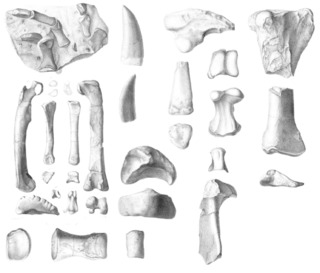
Erectopus is an extinct genus of basal allosauroid theropod from the Early Cretaceous La Penthiève Beds Formation of France and also possibly the Cernavodă Formation of southern Romania. The type species is E. superbus, which was initially known as a species of Megalosaurus.

Kaijiangosaurus is a genus of carnivorous tetanuran theropod dinosaur from the Middle Jurassic of China. In 1984 He Xinlu named and described the type species Kaijiangosaurus lini. The generic name refers to the River (jiang) Kai. The specific name honours the paleontologist Lin Wenqiu.
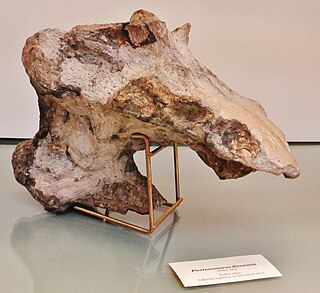
Piveteausaurus is a genus of theropod dinosaur known from a partial skull discovered in the Middle Jurassic Marnes de Dives formation of Calvados, in northern France and lived about 164.7-161.2 million years ago. In 2012 Thomas Holtz gave a possible length of 11 meters.

Streptospondylus is a genus of tetanuran theropod dinosaur known from the Late Jurassic period of France, 161 million years ago. It was a medium-sized predator with an estimated length of 6 meters (19.5 ft) and a weight of 500 kg (1,100 lbs).

Duriavenator is a genus of theropod dinosaur that lived in what is now England during the Middle Jurassic, about 168 million years ago. In 1882, upper and lower jaw bones of a dinosaur were collected near Sherborne in Dorset, and Richard Owen considered the fossils to belong to the species Megalosaurus bucklandii, the first named non-bird dinosaur. By 1964, the specimen was recognised as belonging to a different species, and in 1974 it was described as a new species of Megalosaurus, M. hesperis; the specific name means 'the West' or 'western'. Later researchers questioned whether the species belonged to Megalosaurus, in which many fragmentary theropods from around the world had historically been placed. After examining the taxonomic issues surrounding Megalosaurus, Roger B. J. Benson moved M. hesperis to its own genus in 2008, Duriavenator; this name means "Dorset hunter".

Piatnitzkysauridae is an extinct family of megalosauroid or basal allosauroid dinosaurs. It only consists of three to four known dinosaur genera: Condorraptor, Marshosaurus, Piatnitzkysaurus and possibly Xuanhanosaurus. The most complete and well known member of this family is Piatnitzkysaurus, which also gives the family its name.



































